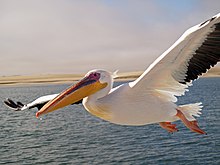Pelecanidae
Appearance
| Pelecanidae | |
|---|---|

| |
| A great white pelican in breeding condition flying over Walvis Bay, Namibia. | |
| Scientific classification | |
| Domain: | Eukaryota |
| Kingdom: | Animalia |
| Phylum: | Chordata |
| Class: | Aves |
| Order: | Pelecaniformes |
| Family: | Pelecanidae Rafinesque, 1815 |
| Type genus | |
| Pelecanus Linnaeus, 1758
| |
| Genera | |
| |
The Pelecanidae is a family of pelecaniform birds within the Pelecani that contains three genera: the extinct Eopelecanus and Miopelecanus and the extant Pelecanus.[4]
Pelecanids have existed since the late Eocene (Priabonian)[5] and they still exist today.[6][7]
References
[edit]- ^ Louchart, Antoine; Tourment, Nicolas; Carrier, Julie (2011). "The Earliest Known Pelican Reveals 30 Million Years of Evolutionary Stasis in Beak Morphology". Journal of Ornithology. 150 (1): 15–20. doi:10.1007/s10336-010-0537-5. S2CID 21016885.
- ^ Kuhl., H.; Frankl-Vilches, C.; Bakker, A.; Mayr, G.; Nikolaus, G.; Boerno, S. T.; Klages, S.; Timmermann, B.; Gahr, M. (2020). "An unbiased molecular approach using 3'UTRs resolves the avian family-level tree of life". Molecular Biology and Evolution. 38: 108–127. doi:10.1093/molbev/msaa191. PMC 7783168. PMID 32781465.
- ^ Milne-Edwards (1863). "Les oiseaux aquatiques (Gaviiformes a Anseriformes) du gisement Aquitanien de Saint-Gerand-le-Puy (Allier, France): revision systematique". Palaeovertebrata (Montpellier). 14 (2): 33–115.
- ^ "Family Pelecanidae". Peru Aves. 2023-04-23. Retrieved 2023-12-18.
- ^ El Adli, Joseph J.; Wilson Mantilla, Jeffrey A.; Antar, Mohammed Sameh M.; Gingerich, Philip D. (2021-06-02). "The earliest recorded fossil pelican, recovered from the late Eocene of Wadi Al-Hitan, Egypt". Journal of Vertebrate Paleontology. 41 (1): e1903910. Bibcode:2021JVPal..41E3910E. doi:10.1080/02724634.2021.1903910. ISSN 0272-4634. S2CID 236269386.
- ^ "Pelicans". Firefly encyclopedia of birds. Christopher M. Perrins. Buffalo, N.Y.: Firefly Books. 2003. p. 78-81. ISBN 1-55297-777-3. OCLC 51922852.
{{cite book}}: CS1 maint: others (link) - ^ Linnaeus, C. (1758). Systema Naturae per Regna Tria Naturae, Secundum Classes, Ordines, Genera, Species, cum Characteribus, Differentiis, Synonymis, Locis. Tomus I. Editio Decima, Reformata (in Latin). Vol. 1. Holmiae: Laurentii Salvii. pp. 132–34.
Rostrum edentulum, rectum: apice adunco, unguiculato. Nares lineares. Facies nuda. Pedes digitís omnibus palmatis.
 Media related to Pelecanidae (category) at Wikimedia Commons
Media related to Pelecanidae (category) at Wikimedia Commons Data related to Pelecanidae at Wikispecies
Data related to Pelecanidae at Wikispecies


